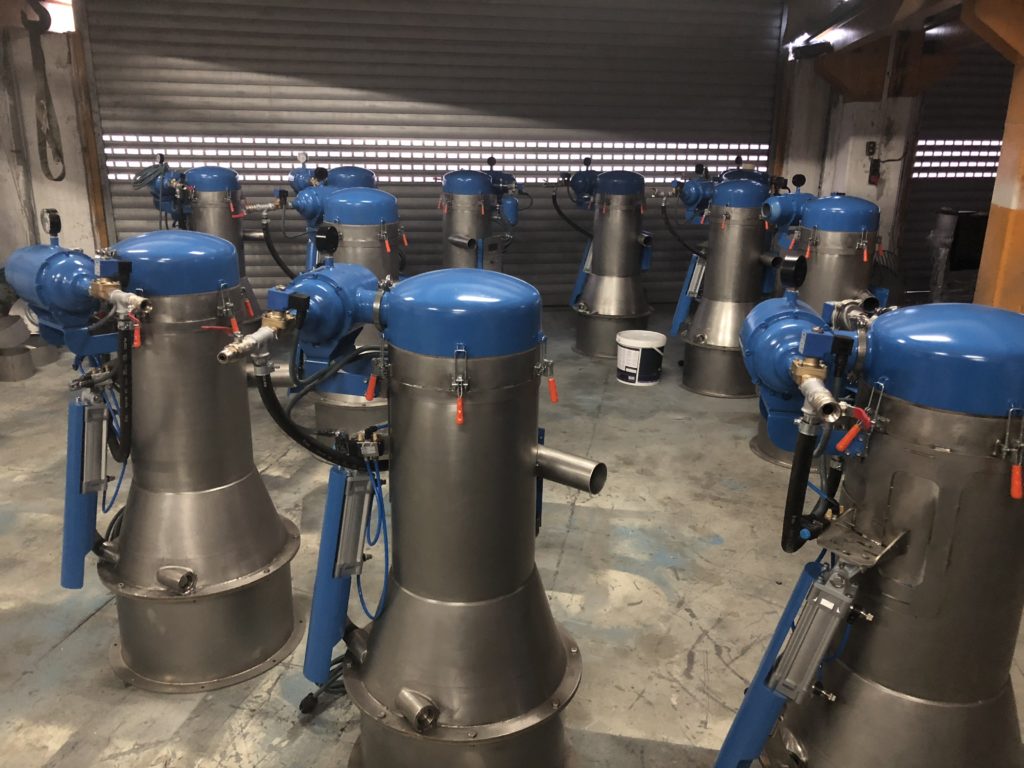
Vacuum Conveying Of Powders
Vacuum Conveying Systems
Raw material handling by means of vacuum conveying
Vacuum conveying systems, usually operating within an absolute pressure ranging from -100 to 800 mbar, are widely used for short distance conveying where dust contamination of production facilities has to be avoid. Depending on the pneuatic ejector vacuum pump used, realistically the lowest absolute pressure which might be operated in industrial conveying systems might be as low as 100 mbar. In vacuum conveying the task which has to be fulfilled is often to convey products from several distribution points to one collecting point( such as mixer, hopper, sieving machine, reactors and etc.) which can a direct mixer feeder as shown in the picture below.
Characteristic applications for vacuum conveying of raw materials
Conveying from several feeding points, for example bag discharging stations or silos, to one delivery point. The delivery point could be for example a high speed mixer or a heater cooler mixer combination.
This system the most simpliest and efficient feeding of raw materials into a system!

When a fixed quality output matters and waste production has to be minimized, vacuum conveying is the best choice. Also Vacuum conveying is used, when a dust free work environment very important matters in order to reduce maintenance costs and down times and other risks caused by a dusty environment.
Due to the restriction of a maximal Δp which will in most of the cases not exceed 760 mbar the conveying distance is limited for many products to 100 m pipeline or less. Furthermore, in vacuum conveying the operator of a system is facing the fact that receiver volumes which are evacuated are limited to 6-8 m3 or less. Bigger volumes vacuum receivers would result in too costly equipment.
360°
The Vacuum Conveying Types
Dilute phase vacuum conveying of raw materials
Practically all kind of raw materials can be conveyed using dilute phase vacuum conveying. In many cases it offers a simple and cost effective solution. Due to the relatively high conveying velocities in the product pipe, resulting in an even product distribution, there is a minor risk of product sedimentation. Ideally dilute phase conveying can be applied for abrasion resistant granular materials which itself are not causing abrasion on pipelines. Since dilute phase conveying is suspending materials evenly even in dense phase conveying pipe empting is achieved using increased gas velocities, respectively by decreasing the solid mass load.
Dilute phase conveying may be applied for any uniform bulk materials with an even particle size distribution where there is no risk of segregation.
This would be the case for pellets, sugar, salt, flour, raw PVC, etc. as long as we don’t mix it with other components with different material properties.
The bigest disadvantage of dilute phase conveying can be found in the wear of pipes and instruments. For sensitive granular or agglomerated products it is not suitable either due particle ruination. Additionally, in terms of energy consumption dilute phase conveying is less interesting since the air or gas volume needed is much higher than in dense phase conveying. As a result of this bigger pneumatic ejector vacuum pumps with higher energy consumption are needed.
There is 2 types dillute phase conveying; dilute phase discontinuous vacuum conveying of raw materials and dilute phase continuous vacuum conveying of raw materials
Dense Phase Vacuum Conveying
- Semi dense phase vacuum conveying
Semi dense phase vacuum conveying allows a soft product flow down to the material jump point where particles are moved away from sediments by the force of the gas velocity. It is recommendable in terms of energy saving and further to treat sensitive products gently, and to protect pipelines from abrasive wear. Densephase vacuum conveying needs in certain cases more complex control algorithms than a simple dilute phase conveying since pipeline pressure drop has to be kept in a certain range to keep the solids to air ratio stable. The typical application area is when fragile materials like chips, tablets or extruded rice needs to be vacuum conveyed.
Dense phase conveying, especially for vacuum conveying of mixtures
Dense phase conveying is particularly recommendable for light materials or very abrasive materials as glass fiber filled plastic pellets with fiberglass contents over 35%. But also greasy products as high fat containing cocoa may be advisably pneumatic conveyed by dense phase vacuum conveyor at low speeds. A clear advantage is that high product flows can be achieved with a minimum air load, respectively with minimized energy consumption.
When it comes to segregation free conveying of mixtures with raw materials of a wide spectrum of particle density and sizes it is almost necessary to go for a dense phase vacuum system if a batch cannot be remixed before packaging!
Some improvement can be achieved using pulsed air or gas injection which is creating a plug flow from the distribution to the receiving point. Product mixes conveyed this way will be transported absolutely segregation free. TeknoConvey developed its own system to control dense phase plug flow, with the vacuum plus conveying system.